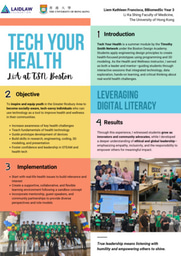LiA Project Outline: Timothy Smith Network
Title of LiA project
Boston Design Academy: Tech Your Health – Empowering Youth through Health Technology
The Organization / Charity
Timothy Smith Network – Boston Design Academy
The Need or Cause Being Supported
The Timothy Smith Network (TSN) is dedicated to bridging the digital divide in the Greater Roxbury Area by equipping underrepresented youth with the skills, resources, and opportunities necessary to thrive in technology-driven fields. Through the Boston Design Academy’s “Tech Your Health” module, students are empowered to address real-world health and wellness challenges in their communities using technology, creative problem-solving, and design thinking.
As summer interns, students will work alongside instructors to gain hands-on experience with programming and 3D modeling, fostering both their technical and personal development. The TYH program uniquely merges health awareness with technology, encouraging youth to innovate solutions for both physical and mental health challenges faced locally.
Objectives
The primary goal of this LiA project is to inspire and prepare youth in the Greater Roxbury Area to become socially-aware, tech-savvy individuals who can use technology as a tool to improve health and wellness in their communities.
The TYH program aims to:
- Raise awareness of prevalent health and wellness challenges (both local and global)
- Equip students with foundational knowledge in health technology, including sensors, devices, and wellness trends
- Guide students in the design and development of a novel wearable health or wellness prototype
- Foster skills in research, engineering design, coding, 3D modeling, and public presentation
- Support students in building confidence and competence as future leaders in STEAM and health technology
Barriers or Risks
- Varied levels of prior knowledge and interest in health technology among students
- Limited time within the six-week program to cover all necessary content and complete prototypes
- Challenges in engagement due to the complexity of some technical concepts (e.g., sensors, coding, 3D modeling)
- Ensuring inclusive participation and equitable access to resources
- Bridging potential gaps between students (interns) and instructors (scholars)
Ideas to Overcome Barriers
- Begin the program by exploring relatable, real-life health and wellness issues to build relevance and interest
- Use a structured, modular curriculum with clear weekly objectives to guide progress
- Foster a supportive, flexible learning environment where students feel comfortable asking questions and experimenting
- Mix instruction with hands-on activities, group discussions, and peer collaboration to reinforce learning
- Leverage mentorship, guest speakers, and community partnerships to provide diverse perspectives and role models
- Set clear expectations for respectful, inclusive participation, and model ethical leadership throughout
Milestones per Week
| Week | Milestones | Details |
|---|---|---|
| 1 | Introduction to Community Health & Tech | Explore local and global health and wellness challenges, introduce health monitoring technologies, examine existing devices, and analyze relevant datasets. Students participate in mock debates and public speaking activities, form teams, and select a health issue to focus on — all while becoming familiar with the fundamentals of engineering design. |
| 2 | Exploring Health Tech and Design | Teach principles of technology design, sensors, and information technology through the introduction of Python programming and Arduino. Students research and compare existing health monitoring devices. Dive deeper into their brainstorming of new product ideas. |
| 3 | 3D Modeling Technology Applications & Ideation | Guide students in technology applications, microelectronics basics, and design thinking. Facilitate ideation sessions and initial concept sketches for health tech prototypes. Ease into 3D modeling. |
| 4 | Prototype Development | Continue with the teaching of fundamentals of coding, 3D modeling, and prototype assembly. Students start developing their prototypes, working with microelectronics and design tools on multiple platforms. |
| 5 | Prototype Refinement | Continue prototype development, troubleshooting, and refinement. Students test device functionality and prepare demonstration / presentation materials. |
| 6 | Final Presentation & Exhibition | Finalize prototypes, prepare and practice presentation materials. Guide students in pitching their projects and demonstrating prototypes at the exhibition for guests, sponsors, and the community. |

Please sign in
If you are a registered user on Laidlaw Scholars Network, please sign in